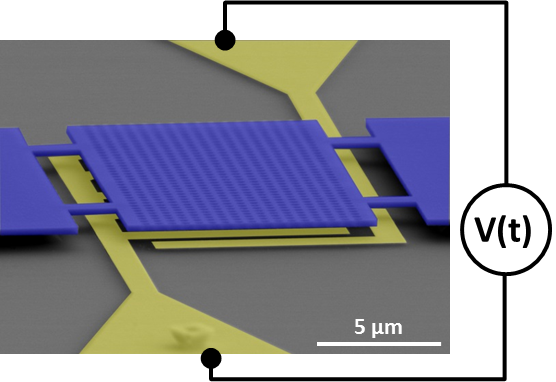Involved people : Gladys JARA-SCHULZ (PhD), Guilhem MADIOT (PhD), Franck CORREIA (Post-Doc), Rémy BRAIVE
In ordinary consciousness, noise is associated with the term “hindrance”; it is considered as a nuisance that can lead to communication or signal transmission failure or prevent the detection of a weak signal to be measured. However, intensive investigations, performed in the last decades, have shown that under certain conditions the impact of noise can be counter-intuitively a resource. In nonlinear systems, noise can induce novel regimes leading to the formation of synchronized structures, coherence between the output and the input of resonators or even to the amplification of weak signals. In other words, noise can play a constructive role, with potential benefits for signal processing or measurement for instance.
Objectives
We aim at enlarging the scope and potential use of such noise-aided processes with strong impact in noise-assisted applications including signal processing or sensing. It will extend their field of application by harnessing noise induced phenomena in novel playground formed by single and coupled Nano-Opto-ElectroMechanical resonators
Collaborators

Figure 1: Suspended photonic crystal membrane (blue) on top of integrated interdigitated electrodes (yellow) used to put into motion the membrane. Mechanical displacement is read with an external interferometric set-up.

Figure 2: Different possible couplings between opto-electro-mechanical oscillators: (Top left) one optomechanical photonic crystal electromechanical driven probe with a SOI waveguide, (top right) two coupled photonic crystal cavity probe with a SOI waveguide, (bottom left) two membranes mechanically coupled, (bottom right) five coupled electromechanical membranes
Highlights:


(Physical Review Letters, 2017)

(Applied Physics Letters, 2016)
Publications:
Random number generation with a chaotic electromechanical resonator
G. Madiot, F. Correia, S. Barbay and R. Braive
arXiv:2204.13403
Bichromatic synchronized chaos in coupled optomechanical nanoresonators
G. Madiot, F. Correia, S. Barbay and R. Braive
Phys. Rev. A 104, 023525 (2021)
arXiv:2005.08896
Weak signal enhancement by nonlinear resonance control in a forced nano-electromechanical resonator
A. Chowdhury, M. G. Clerc, S. Barbay, I. Robert-Philip, and R. Braive
Nat. Communications 11, 2400 (2020)
Phase Stochastic Resonance in a Forced Nanoelectromechanical Membrane
A. Chowdhury, S. Barbay, M. G. Clerc, I. Robert-Philip, and R. Braive
Phys. Rev. Lett. 119, 234101 (2017)
Superharmonic resonances in a two-dimensional non-linear photonic-crystal nano-electro-mechanical oscillator
A. Chowdhury, I. Yeo, V. Tsvirkun, F. Raineri, G. Beaudoin, I. Sagnes, R. Raj, I. Robert-Philip, and R. Braive
Appl. Phys. Lett. 108, 163102 (2016)
2D photonic-crystal optomechanical nanoresonator
K. Makles, T. Antoni, A. G. Kuhn, S. Deléglise, T. Briant, P.-F. Cohadon, R. Braive, G. Beaudoin, L. Pinard, C. Michel, V. Dolique, R. Flaminio, G. Cagnoli, I. Robert-Philip, and A. Heidmann
Optics Letters 40 (2), 174 (2015)
Nonlinear mechanics with suspended nanomembranes
T. Antoni, K. Makles, R. Braive, T. Briant, P.-F. Cohadon, I. Sagnes, I. Robert-Philip and A. Heidmann
EPL (Europhysics Letters) 100 (6), 68005 (2012)
Deformable two-dimensional photonic crystal slab for cavity optomechanics
T. Antoni, A. G. Kuhn, T. Briant, P.-F. Cohadon, A. Heidmann, R. Braive, A. Beveratos, I. Abram, L. Le Gratiet, I; Sagnes, and I. Robert-Philip
Optics Letters 36 (17), 3434 (2011)